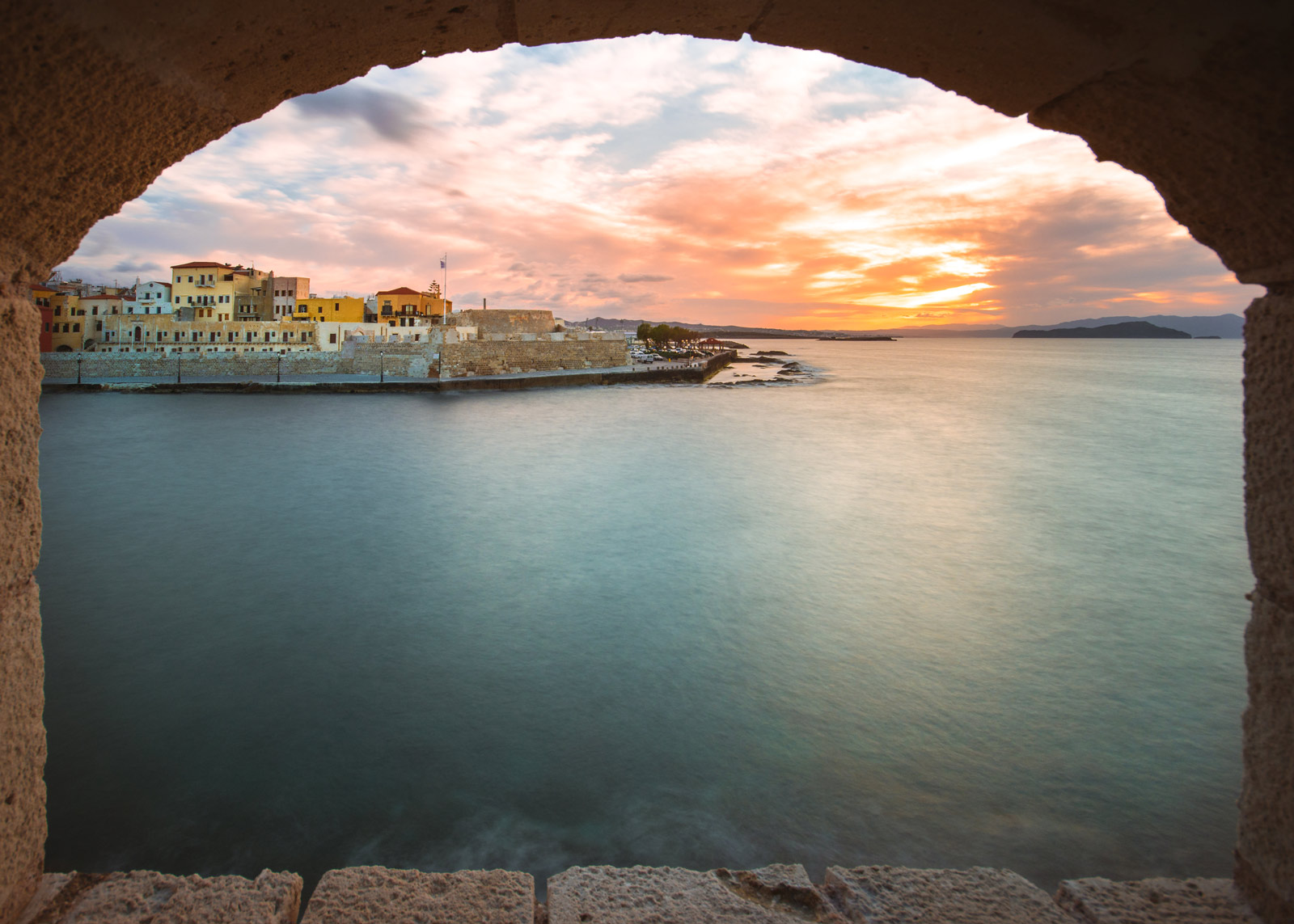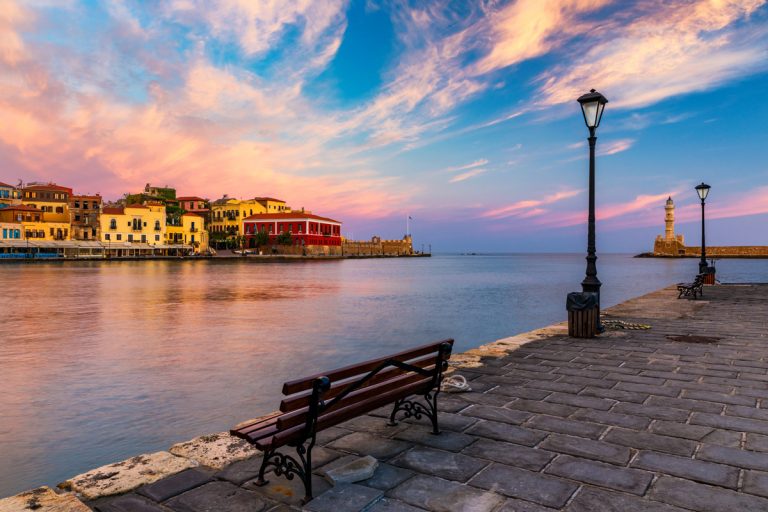
CHANIA OLD VENETIAN HARBOUR
The Old Venetian Harbour of Chania is a top-class world attraction, which should be in the “100 places to visit” list of every world traveler. Built in the 14th century during the Venetian era of Crete, it was second in importance only after the Venice Harbour itself. Its purpose was to make Chania a center of maritime trade in the Eastern Mediterranean, and to protect the city from pirate raids, and it was so big that it could contain up to 40 Venetian galleys.
The landmark of the harbour, lying on the edge of the Venetian Sea Wall, is the distinctive Lighthouse, which has been superbly restored. On the other side of the harbour entrance you will see the big, red-colored Firkas Fortress, which now houses the Maritime Museum of Crete. In the center of the harbour you can find the Kioutsouk Hasan mosque, with its characteristic unique shape. On the eastern side of the old harbour, behind the modern small harbour, you can find the huge Venetian Arsenalis, or Neoria. The biggest of them, the Grand Arsenali, now houses the Center of Mediterranean Architecture. In the Venetian Harbour of Chania you will be impressed by the variety of buildings with exquisite architecture from all the different historical periods of the city. But you will be amazed by the once-in-a-lifetime feeling to be in a unique, wonderful place, that seems to have come out of history books, and which will travel you back in time.
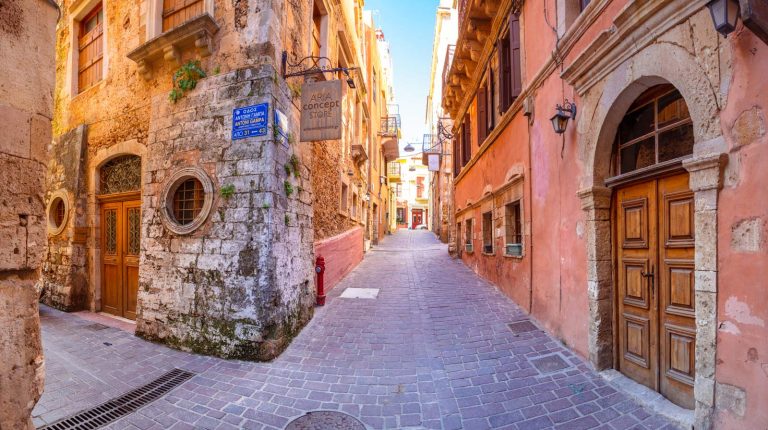
CHANIA OLD TOWN
The Old Town of Chania lies right behind the Old Venetian Harbour. It is as unique as the harbour itself, as it is essentially a labyrinth of narrow, winding alleys, offering you an infinite selection of cafes, taverns, restaurants, bars and shops, where you can find yourself wandering for hours, always discovering something new.
The architectural styles of the buildings, ranging in architecture from Venetian to Ottoman to Jewish, could not be more diverse, yet they all somehow coexist harmonically together, the end result being simply stunning. Possibly the most central street of the Old Town is Halidon street, leading right to the center of the Old Venetian Harbour. On its side you can find the superb Archaeological Museum of Chania. Opposite to the museum, there is a picturesque square, where the “Trimartiri” church, the Cathedral of Chania, is located. Close to it you can find Sklidroff street, with many shops selling everything, from leather goods, which Chania is renowned for, to tasteful souvenirs. Through the centuries, the Old Town of Chania has managed to retain its past glory as the center of activity in the city, providing an experience you will remember for a lifetime.
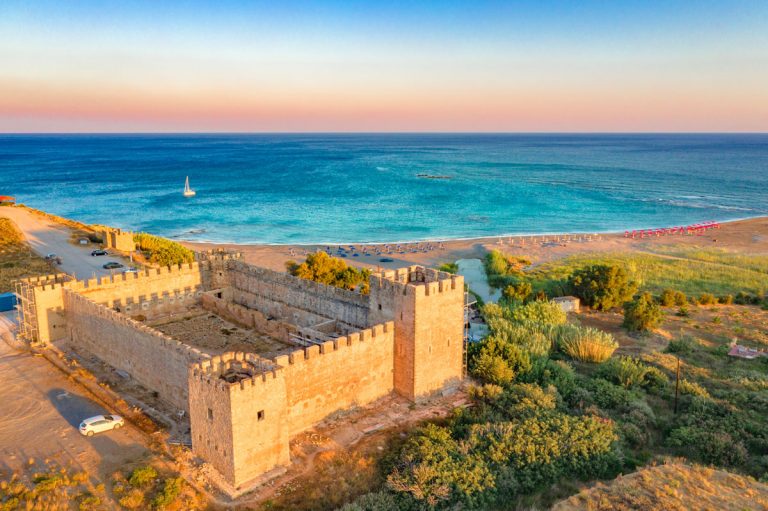
FRANGOKASTELLO CASTLE
Frangokastello Castle is an impressive castle in the south of Chania region, in the Sfakia area. It is in a distance of about 70 km from Chania city and it is easily accessible by car. The castle was built in the 14th century by the Venetians and was originally called “Castel Franco”. The impressive castle is in extremely good condition, with a beautiful popular beach in front of it.
Today’s peaceful natural environment is in contrast with the fierce battle that took place here in 1828, when Hatzimihalis Dalianis, a Cretan hero of the Greek revolution, and his men gave their last – and fatal – heroic battle against the occupying Ottoman army, which heavily outnumbered them. Until today, there are many locals that will tell you about the strange “Drosoulites” phenomenon, when sometimes soldier-like shadows are seen walking towards the castle in the early morning…
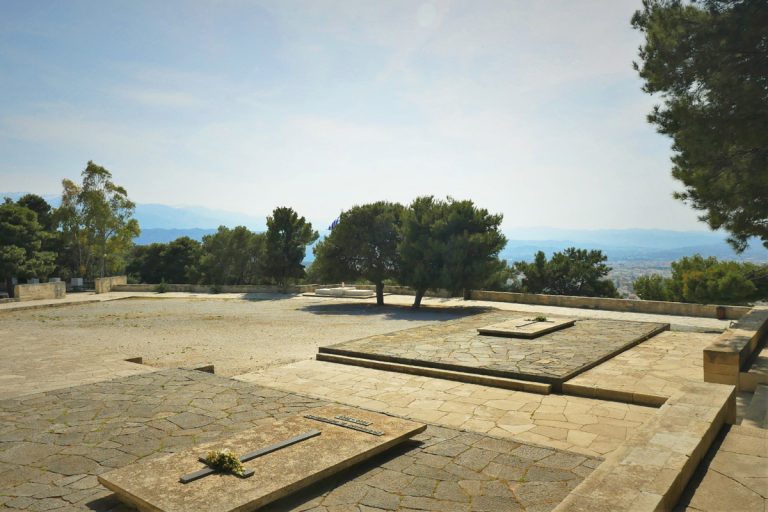
VENIZELOS GRAVES
Eleftherios Venizelos was the most prominent politician in modern Greek history, defining the country’s fate during the years he served for seven times as Prime Minister of Greece in the beginning of the 20th century – Athens International Airport, the biggest in Greece, is named after him. Venizelos was born in Chania, and now, in a shady place in the outskirts of the city close to the road to Akrotiri, lies his grave, along with the grave of his son Sophocles Venizelos, who also became a Prime Minister of Greece.
The site, on top of a hill, offers one of the best views of Chania city and the coastline around it. In the site there is also the picturesque small church of Profitis Ilias and the statue of Spyrus Kagialedakis or Kagiales, a Cretan hero of the Greek revolution against the Ottomans.
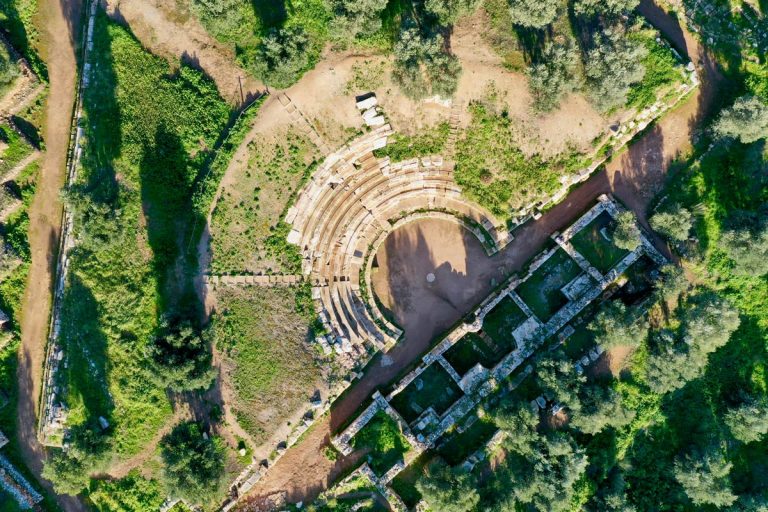
ANCIENT APTERA
Ancient Aptera was a powerful city-state in ancient Minoan Crete, and for many centuries the most important trading center in the island. It is in a distance of about 15 km east of Chania city, next to today’s village of Aptera. It was built in an excellent, strategic location with great view, overlooking the whole of the long Souda Bay and a large part of the plains of Apokoronas.
Aptera means “featherless” in Greek and there is reason for this: According to the Greek mythology, in the local temple a musical competition took place between the Muses and the Sirens. The Sirens lost, and were so sad that their feathers fell off into Souda Bay, forming the small islands in it. Aptera in ancient Minoan years had amassed immense wealth from maritime trade, and issued its own coin. The city flourished for many centuries, and it was a trading center in the Roman and even in the Byzantine era of the island.
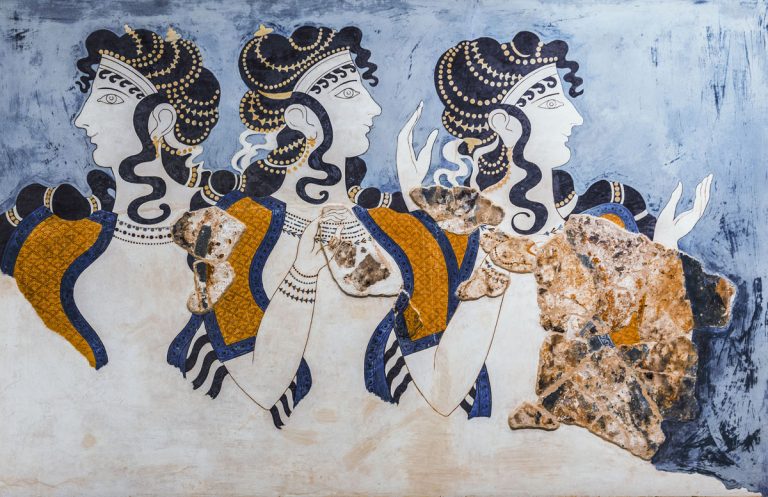
HERAKLIO ARCHAEOLOGICAL MUSEUM
The Heraklio Archaeological Museum is located in the center of the city and is one of the most important museums in Europe. It houses
the impeccable Minoan Collection, containing a wealth of invaluable artifacts of the Minoan Civilization, including world-class archaeological masterpieces.
The Minoan Civilization was the first advanced civilization in Europe, and flourished in Crete from 3000 BC up to 1100 BC, leaving behind astonishing monuments like the Palaces of Knossos and Phaistos, artworks of very high quality, and advanced writing systems, among others. The Heraklio Archaeological Museum includes findings and artifacts from all the periods of Cretan prehistory and history, covering a chronological span of over 5,500 years from the Neolithic period to Roman times. The first museum started functioning as early as 1883, featuring a simple collection of antiquities. The present day museum was built between 1937 and 1940. It is an antiseismic building which is an important example of Greek modernist architecture in the Bauhaus style.
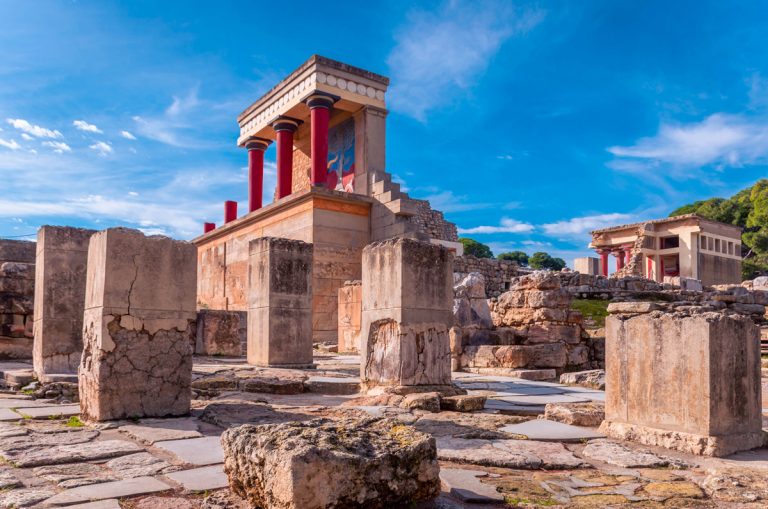
KNOSSOS
No other archaeological site is more characteristic of Crete than the Palace of Knossos. Located just 5 km south of Heraklio city, Knossos Palace marks the climax of the Minoan Civilization, the first advanced civilization in Europe that flourished in Crete. Knossos Palace was unearthed by excavations that lasted 3 decades in total (1900 – 1930) by the British archaeologist Sir Arthur Evans, who also undertook an extensive restoration of the palace.
The site’s first settlements date back to the Neolithic period (7.000-3.000 BC) and it has been continually inhabited since then. The first smaller palace was built at around 1.900 BC and it was destroyed in 1.700 BC, most probably by an earthquake. The current second – and larger – palace was built on top of the older palace, and was finally destroyed at around 1.350 BC, after the arrival of Mycenaeans in Crete. The palace has superb architecture and demonstrates a very advanced level of building technology, like the use of beams to reinforce the masonry, and the complex drainage and water-supply systems. It was a multi-storey building with a vast total area of 20.000 sq m. In the center of the palatial complex there is a characteristic large Central Court, which is the ideal place to take great photos.
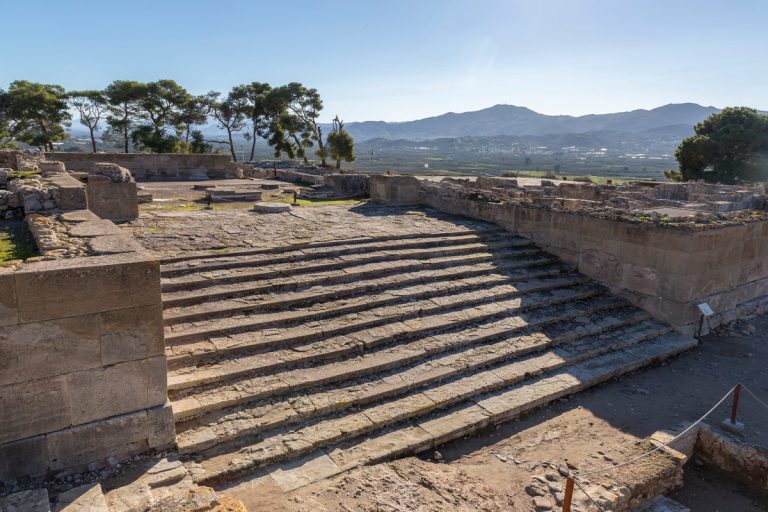
PHAISTOS
Phaistos, or Phaestos as it is also known, is the place where the second majestic Minoan Palace was found, after the one in Knossos. The settlement was first inhabited around 3.000 BC, although some historians argue that the first settlements date back to 6.000 BC. From the two-palace complex that was unearthed in the site, one built partially on top of the other, the first palace dates to about 1.900 BC and the second to about 1.700 BC.
The architecture of the palace is simpler than the one in Knossos, but its location is outstanding: On top of a hill, overlooking the large Messara plain. A characteristic architectural feature of the Phaisots Palace is the expansive courtyards that complement the massive buildings. Another thing that impresses any visitor is the importance of proper sanitation in ancient Minoan architecture, which is evident in the irrigation system under the central courtyard and the entire palace. The palace of Phaistos was destroyed in about 1.400 BC, but was in partial use for another 12 centuries, until its final destruction in 200 BC.
